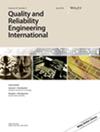Selection of the level of vibration signal decomposition and mother wavelets to determine the level of failure severity in spur gearboxes
IF 2.2
3区 工程技术
Q3 ENGINEERING, INDUSTRIAL
引用次数: 0
Abstract
Spur gearboxes are an integral component in the operation of rotary machines. Hence, the early determination of the severity level of a failure is crucial. This manuscript delineates a methodology for selecting essential mother wavelets and filters from the wavelet transform (WT) to process the vibration signal within the time‐frequency domain, aiming to ascertain the severity level of failures in spur gearboxes. Initially, information is garnered from the gearbox through vibration signals in the time domain, utilising six accelerometers. Subsequently, the signal is partitioned into various levels, and information from each level is extracted using diverse mother wavelets and their respective filters. The signal is segmented into sub‐bands, from which the condition state is ascertained using an energy operator. After that, the appropriate level of wave decomposition is determined through ANOVA tests and post‐hoc Tukey analyses, evaluating performance in failure classification via the Random Forest (RF) model. Upon establishing the decomposition level, the analysis proceeds to identify which mother wavelets and filters are most suitable for determining the severity level of different types of failure in spur gearboxes. Moreover, this study investigates the impact of sensor positioning and inclination on acquiring the vibration signal. This aspect is explored through factorial ANOVA tests and multiple comparisons of the data derived from the sensors. The RF classification model achieved exceedingly favourable results (accuracy 96% and AUC 98%), with minimal practical influence from the positioning and inclination of a sensor, thereby affirming the proposed methodology's suitability for this type of analysis.选择振动信号分解级别和母波来确定正齿轮箱的故障严重程度
正齿轮箱是旋转机械运行中不可或缺的部件。因此,尽早确定故障的严重程度至关重要。本手稿阐述了一种从小波变换 (WT) 中选择基本母波和滤波器的方法,以处理时频域内的振动信号,从而确定正齿轮箱故障的严重程度。首先,利用六个加速度计通过时域振动信号收集齿轮箱的信息。随后,将信号划分为不同的级别,并使用不同的母小波及其各自的滤波器提取每个级别的信息。信号被分割成子带,并利用能量算子从中确定状态。然后,通过方差分析测试和事后 Tukey 分析确定适当的波分解级别,并通过随机森林(RF)模型评估故障分类的性能。在确定分解级别后,分析将继续确定哪些母小波和滤波器最适合用于确定正齿轮箱中不同类型故障的严重程度。此外,本研究还探讨了传感器定位和倾斜度对获取振动信号的影响。通过对传感器数据进行因子方差分析测试和多重比较,对这方面进行了探讨。射频分类模型取得了非常理想的结果(准确率 96%,AUC 98%),传感器的定位和倾斜度对其实际影响极小,从而肯定了所提出的方法适用于此类分析。
本文章由计算机程序翻译,如有差异,请以英文原文为准。
求助全文
约1分钟内获得全文
求助全文
来源期刊
CiteScore
4.90
自引率
21.70%
发文量
181
审稿时长
6 months
期刊介绍:
Quality and Reliability Engineering International is a journal devoted to practical engineering aspects of quality and reliability. A refereed technical journal published eight times per year, it covers the development and practical application of existing theoretical methods, research and industrial practices. Articles in the journal will be concerned with case studies, tutorial-type reviews and also with applications of new or well-known theory to the solution of actual quality and reliability problems in engineering.
Papers describing the use of mathematical and statistical tools to solve real life industrial problems are encouraged, provided that the emphasis is placed on practical applications and demonstrated case studies.
The scope of the journal is intended to include components, physics of failure, equipment and systems from the fields of electronic, electrical, mechanical and systems engineering. The areas of communications, aerospace, automotive, railways, shipboard equipment, control engineering and consumer products are all covered by the journal.
Quality and reliability of hardware as well as software are covered. Papers on software engineering and its impact on product quality and reliability are encouraged. The journal will also cover the management of quality and reliability in the engineering industry.
Special issues on a variety of key topics are published every year and contribute to the enhancement of Quality and Reliability Engineering International as a major reference in its field.

 求助内容:
求助内容: 应助结果提醒方式:
应助结果提醒方式:


